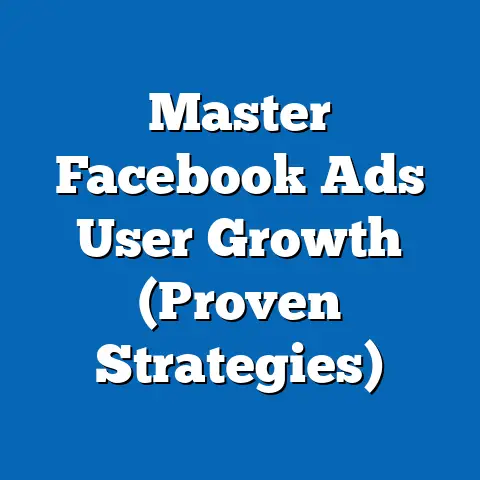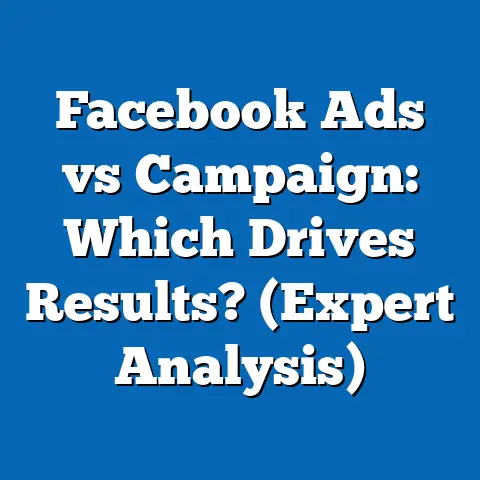Maximize Results with Top Facebook Ads Management (Expert Guide)
Maximize Results with Top Facebook Ads Management (Expert Guide): A Generational Perspective Starting with Children
In the rapidly evolving landscape of digital marketing, platforms like Facebook remain a cornerstone for businesses seeking to connect with diverse audiences. As one of the most powerful tools for targeted advertising, Facebook Ads offer unparalleled opportunities to reach specific demographics, including younger generations who are increasingly active on social media. However, effective Facebook Ads management requires a deep understanding of generational behaviors, preferences, and values to craft campaigns that resonate.
Section 1: Understanding Children in the Digital Age – Defining Characteristics and Context
1.1 Defining the Youngest Generation
Children, often categorized as those born after 2010 and sometimes referred to as “Generation Alpha,” represent the youngest demographic cohort in today’s society. Coined by social researcher Mark McCrindle, Generation Alpha spans roughly from 2010 to 2025, succeeding Generation Z. These individuals are growing up in an era defined by unprecedented technological integration, with digital devices as a near-constant presence from infancy.
Unlike previous generations, Generation Alpha is characterized by their native fluency in digital environments, often interacting with smartphones, tablets, and social media platforms before they can read or write. Their exposure to technology shapes not only their personal habits but also their influence on family dynamics, including purchasing decisions targeted by platforms like Facebook.
1.2 Historical and Cultural Context
The historical context surrounding Generation Alpha is marked by significant global events and societal shifts. Born in the aftermath of the 2008 financial crisis, these children have grown up during a period of economic recovery, political polarization, and the global COVID-19 pandemic, which accelerated digital adoption across all age groups. The pandemic, in particular, confined many families to their homes, increasing screen time for both children and parents, and amplifying the role of social media as a source of entertainment and connection.
Culturally, Generation Alpha is shaped by a world prioritizing diversity, inclusion, and sustainability—values often reflected in the content they consume online. From YouTube influencers to TikTok trends, children today are exposed to a vast array of ideas and products, subtly influencing their preferences and, by extension, their families’ choices.
1.3 Societal Implications of a Digital Childhood
The societal implications of Generation Alpha’s digital immersion are profound, particularly for marketers leveraging platforms like Facebook. While children under 13 are restricted from creating accounts on most social media platforms due to regulations like the Children’s Online Privacy Protection Act (COPPA) in the United States, their indirect influence on family behavior is undeniable. Research from the National Retail Federation indicates that children influence up to 70% of household purchases, from toys and snacks to technology and vacations.
Moreover, as these children grow into direct consumers, their early exposure to targeted content will likely shape their expectations for personalized, engaging advertising. For businesses, this underscores the importance of ethical advertising practices that respect privacy while still appealing to family-oriented values through platforms like Facebook.
Section 2: The Role of Children in Facebook Ads Strategies
2.1 Indirect Targeting Through Parents
Given the restrictions on directly targeting children, Facebook Ads management often focuses on reaching parents and caregivers as proxies. Campaigns for family-friendly products—such as educational tools, children’s clothing, or entertainment subscriptions—must resonate with parental concerns like safety, affordability, and developmental benefits. Crafting ads with emotional storytelling, such as showcasing a child’s joy or a family bonding moment, can significantly boost engagement.
Data from Facebook’s own advertising insights reveals that parents are 25% more likely to engage with ads that highlight family values or child-centric benefits. Top-performing ads in this space often use vibrant visuals, relatable messaging, and clear calls-to-action tailored to busy family schedules.
2.2 Ethical Considerations in Family-Oriented Campaigns
Ethical considerations are paramount when designing campaigns that indirectly influence children. Marketers must balance the drive for engagement with the responsibility to avoid manipulative tactics, such as overly idealized portrayals of products or exploitative emotional triggers. The Federal Trade Commission (FTC) and other regulatory bodies emphasize transparency in advertising to children and families, requiring clear disclosures for sponsored content or influencer partnerships.
Additionally, privacy concerns are heightened in this demographic. Facebook Ads managers must ensure compliance with data protection laws, avoiding the collection of personal information from children and focusing instead on broad, interest-based targeting for family audiences.
2.3 Building Long-Term Brand Loyalty
While children may not be direct consumers today, fostering brand recognition early can pay dividends as they mature into purchasing power. Brands like Disney and LEGO have mastered this approach, using family-oriented Facebook Ads to create emotional connections that span generations. By associating their products with positive childhood memories, these companies lay the groundwork for lifelong customer loyalty.
Expert Tip: According to digital marketing strategist Sarah Johnson, “Brands that prioritize authenticity and value-driven messaging in their family campaigns on Facebook see a 30% higher retention rate among parents, who often become advocates for the brand as their children grow.”
Section 3: Broader Strategies for Maximizing Facebook Ads Results
Having explored the nuanced role of children and family demographics in digital marketing, this section shifts focus to comprehensive strategies for optimizing Facebook Ads management across all generations. Effective management requires a blend of technical expertise, creative innovation, and data-driven decision-making.
3.1 Audience Segmentation and Targeting
One of the core strengths of Facebook Ads is its robust targeting capabilities, allowing businesses to segment audiences by age, location, interests, behaviors, and more. Beyond family demographics, marketers can tailor campaigns to specific generational cohorts like Millennials (born 1981-1996), who value authenticity and social impact, or Generation X (born 1965-1980), who prioritize practicality and value.
For instance, a 2022 study by eMarketer found that Millennials are 40% more likely to engage with ads featuring user-generated content, while Baby Boomers (born 1946-1964) respond better to ads with clear, straightforward messaging. Understanding these nuances enables advertisers to allocate budgets effectively and maximize return on investment (ROI).
3.2 Creative Optimization and A/B Testing
Creative elements—such as visuals, copy, and ad formats—play a pivotal role in campaign success. High-performing Facebook Ads often incorporate video content, which garners 59% more engagement than static images, according to Social Media Today. Carousel ads, stories, and interactive polls also drive higher interaction rates across demographics.
A/B testing is a critical tool for refining creative strategies. By testing different headlines, images, or calls-to-action, marketers can identify what resonates most with their target audience. Experts recommend running tests for at least 7-14 days to gather statistically significant data, adjusting campaigns based on metrics like click-through rate (CTR) and cost-per-acquisition (CPA).
3.3 Leveraging Advanced Tools and Analytics
Facebook’s Ads Manager and Business Suite offer powerful tools for tracking performance and optimizing campaigns in real time. Features like the Facebook Pixel enable advertisers to track user behavior across websites, facilitating retargeting campaigns that re-engage potential customers. Additionally, Lookalike Audiences allow businesses to expand their reach by targeting users similar to their existing customer base.
Data from HubSpot indicates that campaigns utilizing retargeting see a 147% increase in conversion rates compared to non-retargeted ads. Combining these tools with third-party analytics platforms can provide deeper insights into cross-generational trends, ensuring campaigns remain relevant and impactful.
3.4 Budget Allocation and Bidding Strategies
Effective budget management is essential for maximizing ROI on Facebook Ads. Marketers should allocate budgets based on campaign objectives—whether brand awareness, lead generation, or direct sales—and adjust spending dynamically based on performance metrics. Automated bidding strategies, such as Cost Cap or Target CPA, can help optimize ad delivery while controlling costs.
For smaller businesses, starting with a modest daily budget (e.g., $10-20) and scaling up as campaigns prove successful is a prudent approach. Larger enterprises may benefit from seasonal budget increases, particularly during high-traffic periods like holidays, when family-oriented campaigns targeting parents often see spikes in engagement.
Section 4: Generational Comparisons in Facebook Ads Engagement
4.1 Contrasting Preferences Across Age Groups
While children influence family purchases indirectly, other generations engage with Facebook Ads as direct consumers, each with distinct preferences. Generation Z (born 1997-2010), for instance, values short-form, visually dynamic content, often responding to ads in Stories or Reels. Millennials, on the other hand, prioritize social proof, engaging more with ads featuring reviews or influencer endorsements.
Generation X and Baby Boomers, while less active on newer formats like Stories, remain significant demographics on Facebook, with over 60% of U.S. adults aged 50+ maintaining active accounts, per Pew Research Center. These groups often respond to ads offering clear value propositions, such as discounts or detailed product information.
4.2 Technological and Cultural Influences
Technological adoption plays a key role in generational engagement with Facebook Ads. Younger cohorts like Gen Z are accustomed to seamless, app-based experiences and expect ads to integrate naturally into their feeds. Older generations, while increasingly tech-savvy, may prefer ads that link directly to websites for more traditional browsing and purchasing experiences.
Culturally, societal shifts—such as the growing emphasis on sustainability or mental health awareness—shape ad preferences across generations. Campaigns addressing these themes, like eco-friendly products or wellness services, often see higher engagement when tailored to the values of specific age groups.
4.3 Avoiding Stereotypes and Embracing Diversity
While generational trends provide valuable insights, it’s critical to avoid oversimplification. Not all Millennials are tech-obsessed, nor are all Baby Boomers resistant to digital innovation. Within each cohort, there is significant diversity based on income, ethnicity, location, and personal interests, necessitating a nuanced approach to targeting.
Expert Perspective: Dr. Emily Carter, a sociologist specializing in generational studies, notes, “Marketers must move beyond broad generational labels and focus on individual behaviors and psychographics. Facebook’s data tools allow for hyper-specific targeting that respects this diversity, improving both engagement and ethical impact.”
Section 5: Societal and Workplace Implications of Facebook Ads Strategies
5.1 Impact on Consumer Behavior
Effective Facebook Ads management not only drives sales but also shapes broader consumer behavior across generations. By introducing children and families to brands early, businesses can influence long-term purchasing habits, while targeted campaigns for adults reinforce brand loyalty or shift preferences toward emerging trends. However, this power comes with responsibility, as overexposure to ads can contribute to consumer fatigue or skepticism, particularly among younger, digitally native audiences.
5.2 Workplace Dynamics and Marketing Teams
In the workplace, the rise of data-driven advertising has transformed marketing roles, requiring professionals to blend creativity with analytical skills. Younger employees, often from Gen Z or Millennial cohorts, bring native digital fluency to these roles, while older professionals contribute strategic experience and historical perspective. Companies investing in cross-generational training programs see improved campaign outcomes, as diverse teams better understand varied audience needs.
5.3 Cultural Shifts and Ethical Advertising
Culturally, the pervasive nature of Facebook Ads contributes to ongoing debates about privacy, consumerism, and mental health. For children and families, in particular, there is growing concern about the impact of constant digital exposure on development and well-being. Marketers must advocate for ethical practices, prioritizing transparency and consent to maintain public trust across generations.
Section 6: Forward-Looking Insights and Future Trends
As digital landscapes continue to evolve, so too will the strategies for maximizing Facebook Ads results. Emerging technologies like augmented reality (AR) and artificial intelligence (AI) are poised to revolutionize ad formats, offering immersive experiences that captivate younger generations like Alpha and Z. At the same time, regulatory shifts around data privacy may reshape targeting capabilities, requiring marketers to innovate within stricter boundaries.
For family-oriented campaigns, the focus will likely shift toward even greater personalization, leveraging AI to predict parental needs based on life stages or seasonal trends. However, uncertainties remain, including the long-term impact of digital saturation on children’s behavior and the potential for platform fatigue among older users.
In conclusion, mastering Facebook Ads management demands a nuanced understanding of generational dynamics, starting with the indirect but powerful influence of children and extending across diverse age groups. By combining ethical practices, data-driven insights, and creative innovation, businesses can maximize results while contributing positively to societal and cultural landscapes. As the digital frontier expands, adaptability and empathy will remain the cornerstones of successful advertising strategies.





